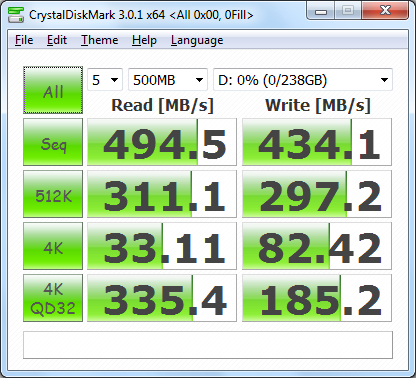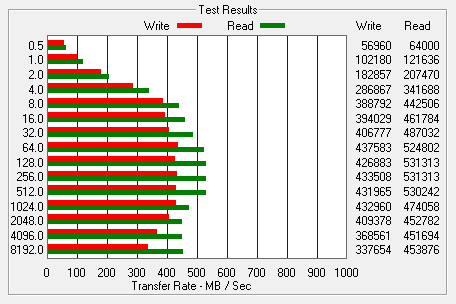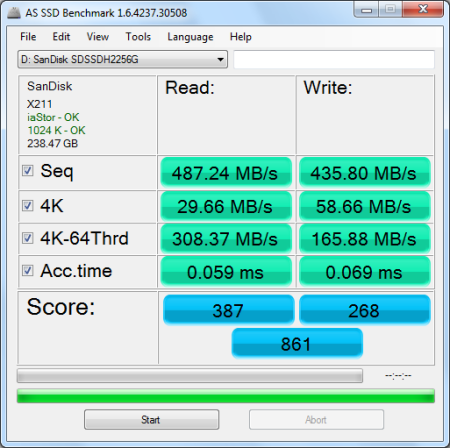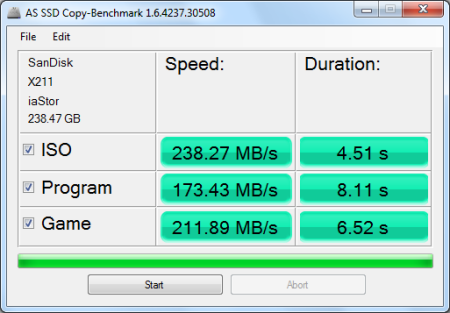

Model: OCZ Agility 4 256GB Solid State Drive
Manufacturer: OCZ Technology
Provided By: OCZ Technology
OCZ Technology is no stranger to the computer industry. Founded by enthusiasts, for enthusiasts, the company entered the memory market in 2002. Determined to manufacture the very best memory for overclockers, OCZ quickly established itself as a leader in the industry by breaking speed barriers and maintaining a reputation of quality. Today, OCZ continues to innovate. Along with their line of enthusiast-oriented power supplies, the company offers a wide range of high-performance SSD solutions for the enterprise and consumer markets.
 One of the latest additions to OCZ's family of mainstream solid state drives is the Agility 4. Available in capacities ranging from 64GB up to 512GB, this cost-effective alternative to the popular Vertex 4 is based on OCZ's advanced Indilinx Everest 2 controller platform. The Everest 2 is powered by a 400MHz dual-core CPU and offers features like TRIM support, dynamic wear-leveling, AES-256 encryption and Ndurance 2.0 technology, which extends the life of NAND flash well beyond its manufacturer rated specifications. In addition to the Everest 2 controller, the Agility 4 is equipped with asynchronous MLC NAND and an extra large DRAM cache to deliver up to 420MB/s read and 410MB/s write speeds as well as a maximum of 85,000 4KB random write IOPS.
One of the latest additions to OCZ's family of mainstream solid state drives is the Agility 4. Available in capacities ranging from 64GB up to 512GB, this cost-effective alternative to the popular Vertex 4 is based on OCZ's advanced Indilinx Everest 2 controller platform. The Everest 2 is powered by a 400MHz dual-core CPU and offers features like TRIM support, dynamic wear-leveling, AES-256 encryption and Ndurance 2.0 technology, which extends the life of NAND flash well beyond its manufacturer rated specifications. In addition to the Everest 2 controller, the Agility 4 is equipped with asynchronous MLC NAND and an extra large DRAM cache to deliver up to 420MB/s read and 410MB/s write speeds as well as a maximum of 85,000 4KB random write IOPS.
For this review, OCZ sent us the 256GB version of the Agility 4. This SSD comes equipped with 512MB of on-board cache and is capable of delivering up to 420MB/s sequential read and 410MB/s sequential write speeds as well as up to 48,000 random read and 85,000 random write IOPS.
| OCZ Agility 4 256GB Solid State Drive | |||||||||||||||||||||||||||||||||||||||||
General Specifications
Performance
Reliability
Power Consumption
Environmental
Dimensions and Weight
Other Features
|
Needless to say, this is only a taste of what the Agility 4 has to offer. To give you an idea of what to expect, we'll take a closer look at OCZ's new SSD and then see how well it performs. Does the Agility 4 have what it takes? Can it deliver the value and performance we've come to expect from OCZ's Agility series? Keep reading as we find out.
Instead of a box, the Agility 4 comes packaged in a plastic clamshell. While there aren't a lot of details on the front, the back of the packaging lists many of the Agility 4's key features including its SATA 6Gbps interface, TRIM support, MLC flash memory and Indilinx Ndurance technology. Inside the clamshell, you'll find the SSD, an installation guide and a sticker that says "My SSD Is Faster Than Your HDD."

Physical Features:
The Agility 4 looks very similar to OCZ's other 2.5" SSDs. The top of the outer casing is made out of plastic and has a matte black finish. There is also a green and black sticker showing that the SSD is part of OCZ's Agility series. The bottom of the casing is made out of metal with a brushed metal finish. The stickers on the bottom show the drive's part number, capacity and serial number.


As I mentioned earlier, the Agility 4 uses the Indilinx Everest 2 (IDX400M00-BC) controller chip. According to reports, this dual-core, ARM-based controller is based on a Marvell design. However, the firmware has been developed entirely by Indilinx. At this point, the only drives using the Everest 2 are OCZ's Vertex 4 and Agility 4 SSDs.


For the 256GB Agility 4, OCZ opted to use their own 16GB 25nm M2502128T048AX22 asynchronous NAND chips. Looking at the pictures above, you can see that there are eight of these chips on either side of the PCB. The drive also has two 256MB Hynix H5TQ2G63BFR-H9C DDR3 memory chips that are used for caching and garbage collection.
The test system used in this review was an HP 8200 Elite. The computer came equipped with an Intel Core i5-2400 CPU, 4GB of DDR3 1333MHz memory, Seagate Barracuda 7200.12 ST3250312AS 250GB SATA 6 Gb/s hard drive, NVIDIA Quadro FX580 512MB PCIe graphics card and an Intel 82579-LM gigabit network card. For the operating system, I installed a fresh copy of Windows 7 Enterprise.
To test the performance of the OCZ Agility 4, I ran a series of benchmarks using CrystalDiskMark 3.0.1, HD Tach RW 3.0.4.0, ATTO Disk Benchmark 2.46, AS SSD, HD Tune Pro 4.61, Anvil's Storage Utilities and Iometer. For comparison, I've also included test results from the SanDisk Ultra Plus, Samsung SSD 840 Pro, Kingston SDNow V300, Silicon Power S70, Plextor PX-256M5P, OCZ Vertex 4, Kingston HyperX 3K, and SanDisk Extreme.

Like the Vertex 4, the Agility 4 is based on the Indilinx Everest 2 controller platform. Looking at the screenshot above, you can see that it performs equally well with both incompressible (0%) and compressible (100%) data.
CrystalDiskMark 3.0.1:
First, I ran a few quick tests using CrystalDiskMark. This benchmark tool measures the performance of a storage device by testing its sequential read and write speeds as well as its random read and write speeds using blocks 512K and 4K in size.
According to OCZ, the 256GB Agility 4 is capable of reading at 420 MB/s and writing at 410 MB/s when connected to a SATA 6 Gb/s port. While the drive performed relatively well, it came up a bit short of these numbers in CrystalDiskMark's sequential read and write speed tests.
The Agility 4 performed equally well when using highly compressible 0x00 (0 Fill) data. This time around, the drive was able to read at 365.4 MB/s and write at 409.3 MB/s.
HD Tach RW 3.0.4.0:
Next, I used HD Tach to test the Agility 4's read, write and burst speeds as well as its seek times and CPU usage.

Looking at the screenshot above, you can see that the Agility 4 had average read and write speeds of 163.5 MB/s and 229.1 MB/s respectively, as well as a burst speed of 151.6 MB/s.
These numbers aren't very impressive and this is primarily due to the Agility 4's performance and data storage modes. By default, the drive operates in performance mode and reads and writes at its maximum speed. The drive maintains this performance level until it's filled to about a quarter of its capacity. At this point, the Agility 4 switches to data storage mode and the read and write speeds drop by half so that it can reorganize the pages on the drive. If you continue to fill the drive without waiting for this task to finish, the writing speed will drop again at the three-quarter mark. Thankfully, these drops in performance are not permanent. Once the Agility 4 is done reorganizing the pages, its performance returns to normal.
ATTO Disk Benchmark 2.46:
I also used ATTO Disk Benchmark to test the Agility 4's sequential read and write speeds. The tests are run using blocks ranging in size from 0.5KB to 8192KB and the total length set to 256MB.
When tested with ATTO, the Agility 4's read speeds topped out at about 421 MB/s and its write speeds at 410 MB/s.
AS SSD:
AS SSD is a relatively new benchmark designed specifically for solid state drives. The application contains five synthetic tests used to determine the sequential and random read and write performance of a drive.
AS SSD also includes a copy benchmark. This test copies an ISO (two large files), program (many small files) and game (small and large files), returning the speed and duration of each.
HD Tune Pro 4.61:
Next, I ran a series of tests using HD Tune Pro. This hard disk utility measures a drive's performance by testing its sequential read and write speeds as well as its access time, burst rate and CPU usage. For this review, I'm also going to use it to benchmark the Agility 4's random read and write speeds, random access times and the number of operations per second.
 OCZ Agility 4 256GB - HD Tune Write Benchmark |
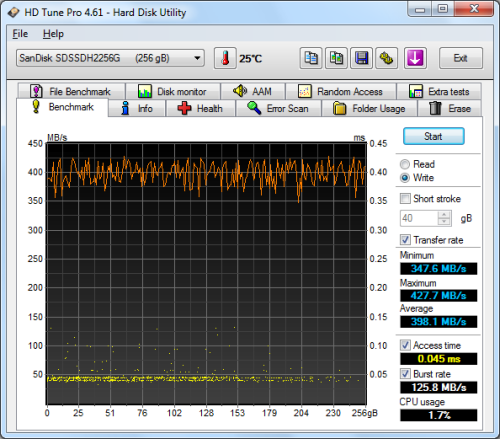 SanDisk Ultra Plus SSD 256GB - HD Tune Write Benchmark |
The Agility 4 performed relatively well when benchmarked with HD Tune. The drive had average read and write speeds of 320.9 MB/s and 357.0 MB/s, respectively, as well as a burst rate of 77.8 MB/s when reading.
 OCZ Agility 4 256GB - HD Tune Random Access Read |
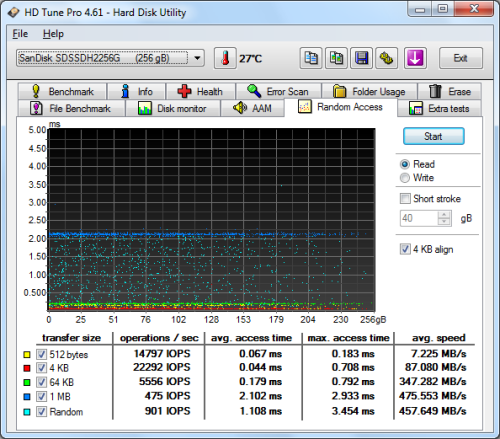 SanDisk Ultra Plus SSD 256GB - HD Tune Random Access Read |
 OCZ Agility 4 256GB - HD Tune Random Access Write |
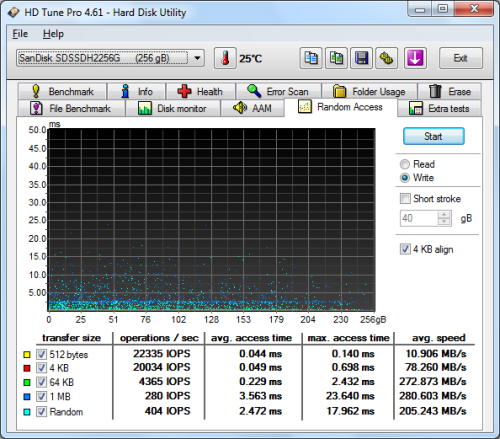 SanDisk Ultra Plus SSD 256GB - HD Tune Random Access Write |
The Agility 4's random read and write performance was hit and miss. The drive lagged well behind the SanDisk Ultra Plus when doing random reads, reaching a mere 5,326 IOPS. The Agility 4 did much better when doing random writes though. In our tests, the drive reached 23,487 IOPS and had an average speed of 91.748 MB/s.
Anvil's Storage Utilities:
Anvil's Storage Utilities is another new benchmark designed with SSDs in mind. The standard storage benchmark measures a drive's performance by testing its transfer speeds, access times and IOPS.

Iometer:
Lastly, I ran a series of tests using Iometer. This tool can be configured to benchmark a number of things. In this case, I used it to measure the Agility 4's read and write speeds and the number of operations per second. The tests were run using random bytes and a queue depth of 3.

The Agility 4's performance was very similar to what we saw in our other tests. The drive was able to read at 383.68 MB/s and write at 386.19 MB/s.

The Agility 4 performed relatively well when doing random reads and writes. In our tests, the drive was able to read at 99.89 MB/s and write at a blazing 309.36 MB/s.

According to OCZ, the Agility 4 is capable of 48,000 IOPS when reading and 85,000 IOPS when writing 4K blocks. In our tests, the drive reached 25,573 random read IOPS and 79,197 random write IOPS. Increasing the queue depth had little impact on the Agility 4's random write performance. However, with the queue depth set to 32, the drive was able to reach 65,247 random read IOPS.
TRIM Performance:
While SSD's offer many benefits, there are some downsides to using flash memory. One of the biggest issues people run into is performance degradation. Over time, an SSD will run out of fresh blocks and will have to write over data the file system has marked as deleted. This procedure is very complicated and can slow an SSD's write speeds considerably.
To fix this problem, most manufacturers have added TRIM support to their SSDs. The TRIM command allows an operating system, such as Windows 7, to tell an SSD which data blocks are no longer in use. Using this information, the drive pro-actively erases these blocks and adds them to the free block pool.

The Agility 4 also uses a number of other flash management techniques including background garbage collection, dynamic and static wear-leveling and advanced flash defect management. Where flash defect management and wear leveling optimize the way data is written on the drive, garbage collection maintains "like new" performance by reorganizing data to maximize the number of free cells.
To test the Agility 4's TRIM and garbage collection functions, I first put the drive in a "dirty" state. I used Iometer to fill the entire drive and then ran a random write test for 30 minutes. Looking at the screenshot below, you can see that the Agility 4's average read and write speeds dropped to 101.0 MB/s and 38.4 MB/s, respectively.

OCZ Agility 4 - Dirty
I let the computer sit for about an hour and a half and then reran the test. Looking at the screenshot below, you can see that the Agility 4's average write speed jumped up to 225.9 MB/s. However, its average read speed dropped down to 92.8 MB/s while it was recovering.

OCZ Agility 4 - After TRIM
Lastly, I used OCZ's Toolbox utility to perform a secure erase on the Agility 4. With the drive wiped clean, it had average read and write speeds of 163.3 MB/s and 401.3 MB/s, respectively.

OCZ Agility 4 - Secure Erased
Final Thoughts:
While not the fastest SSD to come through the 'Labs, OCZ's Agility 4 delivers a lot of bang for your buck. Powered by the same Indilinx infused Everest 2 controller as the Vertex 4, the drive uses asynchronous MLC NAND to deliver a fast, responsive computing experience at a price that cost-conscious consumers will appreciate. In our sequential read and write tests, the Agility 4 was able to read at speeds as high as 421 MB/s and write at speeds in excess of 409 MB/s. It also did surprisingly well in our random write tests, producing more than 79,000 IOPS at low queue depths. Given, these numbers aren't as high as what we've seen with some of the newer, budget oriented SandForce-based drives. However, the Agility 4 performs equally well with compressible and incompressible data and is still a huge step up over traditional hard drives.
The Agility 4 is available now in 64GB, 128GB, 256GB and 512GB capacities. Prices on Amazon range from $75 up to $380, with the 256GB version reviewed here going for about $200. Other mainstream SSDs like the SanDisk Ultra Plus and Samsung SSD 840 currently sell for less. However, if you shop around, you can often find the 256GB Agility 4 for less than $160 after a mail-in rebate.
Highs:
- Available in 64GB, 128GB, 256GB and 512GB capacities
- Good random read and write performance
- Performs equally well with compressible and incompressible data
- Indilinx Ndurance 2.0 technology extends life of NAND flash
- SATA 6Gb/s interface
- Large DRAM cache
- Supports TRIM, dynamic and static wear-leveling and background garbage collection
- Automatic 256-bit AES encryption
- 3 year warranty
- Reasonably priced
Lows:
- Slower sequential read and write speeds than other drives in its class
- Does not include a 2.5" to 3.5" adapter bracket
- Asynchronous NAND flash





